Discover Florida Nature
It's time to explore the natural Florida


|
|
|
|
|
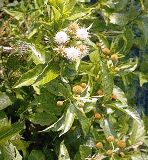 Buttonbush
(Cephalanthus occidentalis)- Buttonbush or Honeyball, is an attractive
large woody shrub with showy, fragrant ball-shaped flower heads. Plant
Button Bush shrubs in sunny, moist soil near a pond or stream or along a
lake shore for protection from erosion caused by waves. The seeds of
our native common buttonbush seeds are eaten by ducks and numerous other
water birds and the fragrant flowers are a favorite nectar source for
butterflies. Wild Common Buttonbush occurs naturally from Florida to
Mexico. Buttonbush is a large, multi-stemmed shrub that grows to a
mature height of twelve feet. It has opposite,
entire leaves 2-6 inches long and 1-3 inches wide.
They are glabrous and green above. The
flowers occur in dense, round, 1 inch diameter clusters which bloom from
June to September. The seed matures in the round
clusters that resemble those of the
sycamore tree. Buttonbush
(Cephalanthus occidentalis)- Buttonbush or Honeyball, is an attractive
large woody shrub with showy, fragrant ball-shaped flower heads. Plant
Button Bush shrubs in sunny, moist soil near a pond or stream or along a
lake shore for protection from erosion caused by waves. The seeds of
our native common buttonbush seeds are eaten by ducks and numerous other
water birds and the fragrant flowers are a favorite nectar source for
butterflies. Wild Common Buttonbush occurs naturally from Florida to
Mexico. Buttonbush is a large, multi-stemmed shrub that grows to a
mature height of twelve feet. It has opposite,
entire leaves 2-6 inches long and 1-3 inches wide.
They are glabrous and green above. The
flowers occur in dense, round, 1 inch diameter clusters which bloom from
June to September. The seed matures in the round
clusters that resemble those of the
sycamore tree.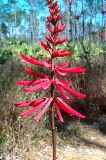 Cherokee
Bean (Erythrina herbacea)- Sometimes called the coral bean, the
Cherokee bean produces herbaceous stems from a woody base that are
typically about 3 ft in height but sometimes more. In areas that
experience freezes the stems are killed back in winter but in frost free
areas the plant will form woody stems and may grow as high as 16 feet.
In late spring and early summer showy scarlet blossoms appear. These
long flattened tubes are about 2 inches long by approximately 1/8 inch
in diameter. They are arranged in clusters at the stem tips and appear
custom designed for hummingbird beaks. Flowers are followed by large
pods that split open to reveal bright red seeds in late summer and fall.
Coralbean is useful for bringing bright highlights to woodland plantings
in low maintenance landscaping. It makes a showy addition to the
perennial garden and attracts both hummingbirds and butterflies Cherokee
Bean (Erythrina herbacea)- Sometimes called the coral bean, the
Cherokee bean produces herbaceous stems from a woody base that are
typically about 3 ft in height but sometimes more. In areas that
experience freezes the stems are killed back in winter but in frost free
areas the plant will form woody stems and may grow as high as 16 feet.
In late spring and early summer showy scarlet blossoms appear. These
long flattened tubes are about 2 inches long by approximately 1/8 inch
in diameter. They are arranged in clusters at the stem tips and appear
custom designed for hummingbird beaks. Flowers are followed by large
pods that split open to reveal bright red seeds in late summer and fall.
Coralbean is useful for bringing bright highlights to woodland plantings
in low maintenance landscaping. It makes a showy addition to the
perennial garden and attracts both hummingbirds and butterflies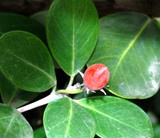 Coco
Plum (Chrysobalanus icaco)- A medium sized shrub or small
tree. The coco plum has a bushy, spreading growth habit and is sometimes
trained into hedges. The coco plum is highly adaptable to coastline
areas and will grow in alkaline conditions. It can withstand both salt
spray and sandy soil. The coco plum is native to coastal areas from
northern South America through Central America, Mexico, the Caribbean,
and Southern Florida. Redtip coco plum is one of the most commonly-used
native plants. You see it all over the place, probably without
realizing it. This is because it is usually box-cut to fit in narrow
places in parking lots and other roadside areas. Coco
Plum (Chrysobalanus icaco)- A medium sized shrub or small
tree. The coco plum has a bushy, spreading growth habit and is sometimes
trained into hedges. The coco plum is highly adaptable to coastline
areas and will grow in alkaline conditions. It can withstand both salt
spray and sandy soil. The coco plum is native to coastal areas from
northern South America through Central America, Mexico, the Caribbean,
and Southern Florida. Redtip coco plum is one of the most commonly-used
native plants. You see it all over the place, probably without
realizing it. This is because it is usually box-cut to fit in narrow
places in parking lots and other roadside areas.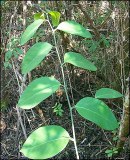 Coin
Vine (Dalbergia ecastophyllum)- A trailing or climbing shrub or
vine with stems to 25 feet in length, the coin vine grows in marshes
behind the sand dunes,
in mangrove swamps and
wherever the tides carry the seed. The fruit are one-seeded pods,
one-half to one inch in diameter. They are flat, round and
copper-colored at maturity accounting for the common name, “coin vine.”
Chemical compounds in these plants cause fish to become stupefied when
roots or bark are crushed and placed in the water, a technique commonly
used by coastal native Americans years ago. The coin vine has small 1/4
inch white flowers in clusters at leaf axils. It's fruit is a copper
colored round pod. Coin
Vine (Dalbergia ecastophyllum)- A trailing or climbing shrub or
vine with stems to 25 feet in length, the coin vine grows in marshes
behind the sand dunes,
in mangrove swamps and
wherever the tides carry the seed. The fruit are one-seeded pods,
one-half to one inch in diameter. They are flat, round and
copper-colored at maturity accounting for the common name, “coin vine.”
Chemical compounds in these plants cause fish to become stupefied when
roots or bark are crushed and placed in the water, a technique commonly
used by coastal native Americans years ago. The coin vine has small 1/4
inch white flowers in clusters at leaf axils. It's fruit is a copper
colored round pod.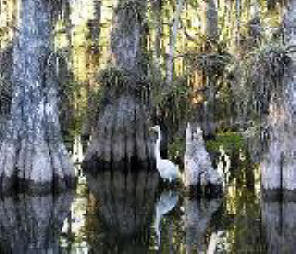 Cypress
Tree -Bald Cypress (Taxodium distichum L)- The bald cypress,
often overgrown with Spanish moss, is the tree that gives the Louisiana
bayous and the Florida everglades their exotic atmosphere. Despite its
association with the South, the bald cypress is hardy and adaptable to
many parts of the continent. The bald cypress has a pyramidal shape
similar to other conifers, with a broad buttressed base. It reaches up
to 100 feet in height in its native environment, but rarely more than 70
feet in culture. In wet situations it develops 'cypress knees': curious
growths which rise out of the ground or water and are believed to help
the tree breathe in swampy conditions. The short green needles turn
brown and drop off in the fall. Its bark is fibrous and an attractive
reddish brown. The small, rounded cones are of little decorative effect. Cypress
Tree -Bald Cypress (Taxodium distichum L)- The bald cypress,
often overgrown with Spanish moss, is the tree that gives the Louisiana
bayous and the Florida everglades their exotic atmosphere. Despite its
association with the South, the bald cypress is hardy and adaptable to
many parts of the continent. The bald cypress has a pyramidal shape
similar to other conifers, with a broad buttressed base. It reaches up
to 100 feet in height in its native environment, but rarely more than 70
feet in culture. In wet situations it develops 'cypress knees': curious
growths which rise out of the ground or water and are believed to help
the tree breathe in swampy conditions. The short green needles turn
brown and drop off in the fall. Its bark is fibrous and an attractive
reddish brown. The small, rounded cones are of little decorative effect. DeerBerry
(Vaccinium stamineum)-The scientific name of deerberry comes from the
Latin word for 'stamen which stick out'. The flowers have prominent
stamen that extend well beyond the petals. Other common names of this
plant are squaw huckleberry, southern gooseberry, or buckberry. This
shrub is sometimes grown as a hedge or background ornamental and
reproduces quickly by runners. In the wild it is often seen in loose
colonies. Deerberry is an important source of food for numerous wildlife
species including wild turkey, quail, Rufus-sided towhee, and various
rodents. White-tailed deer utilize the berries and vegetation as a
significant resource, hence the common name, deerberry. DeerBerry
(Vaccinium stamineum)-The scientific name of deerberry comes from the
Latin word for 'stamen which stick out'. The flowers have prominent
stamen that extend well beyond the petals. Other common names of this
plant are squaw huckleberry, southern gooseberry, or buckberry. This
shrub is sometimes grown as a hedge or background ornamental and
reproduces quickly by runners. In the wild it is often seen in loose
colonies. Deerberry is an important source of food for numerous wildlife
species including wild turkey, quail, Rufus-sided towhee, and various
rodents. White-tailed deer utilize the berries and vegetation as a
significant resource, hence the common name, deerberry.
|
|
|
Advertise | Privacy Statement | Dog Encyclopedia | Video |Contact | Alaska Nature |
|